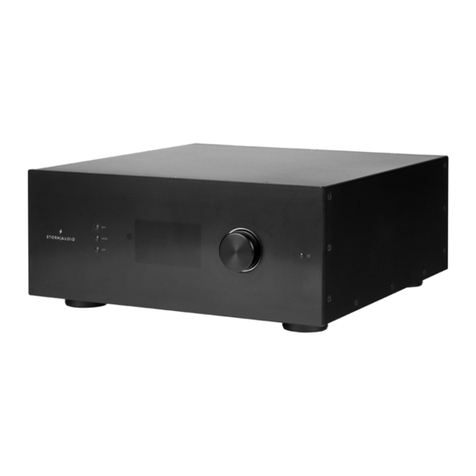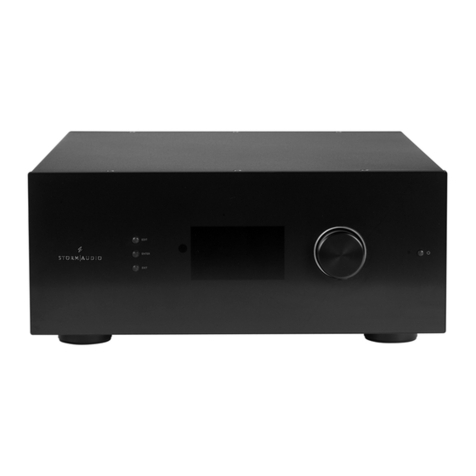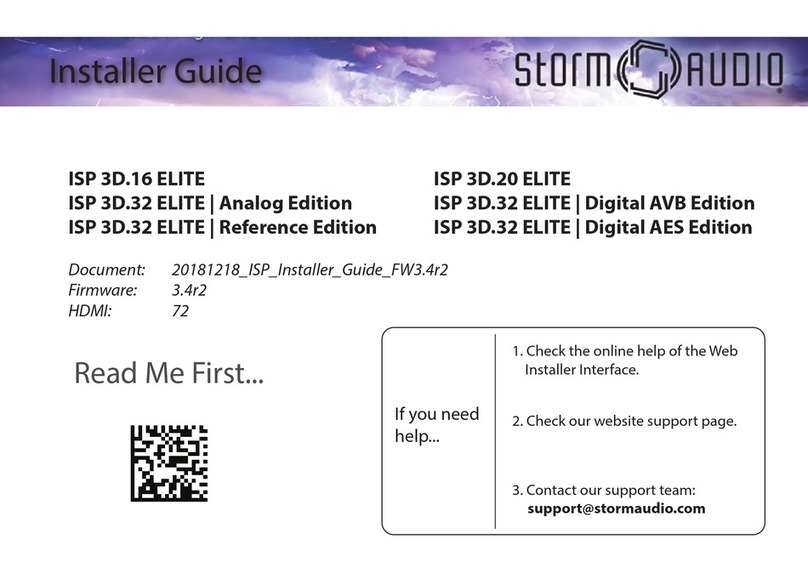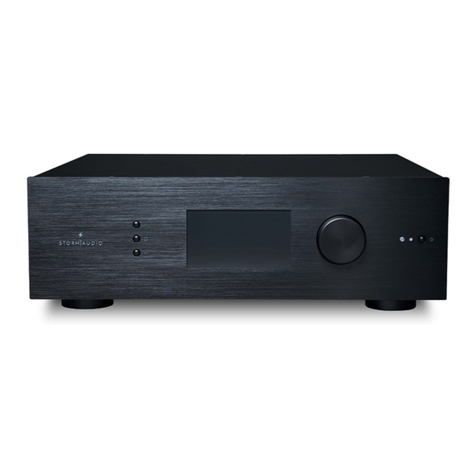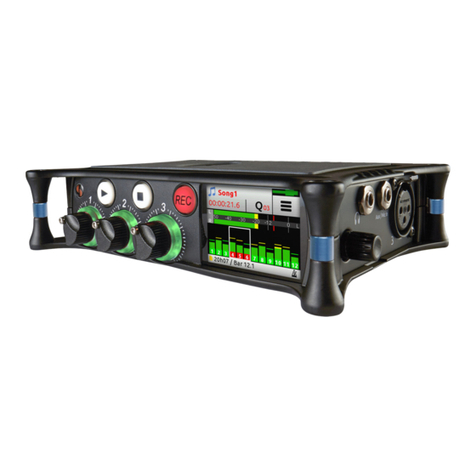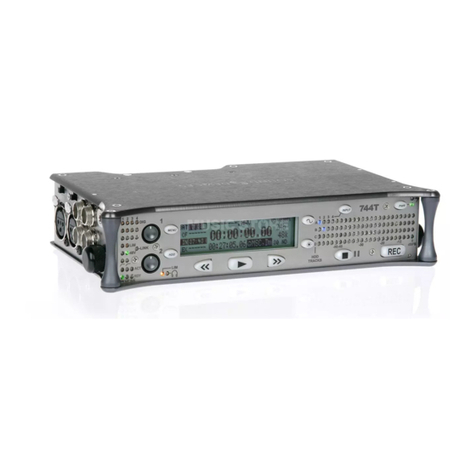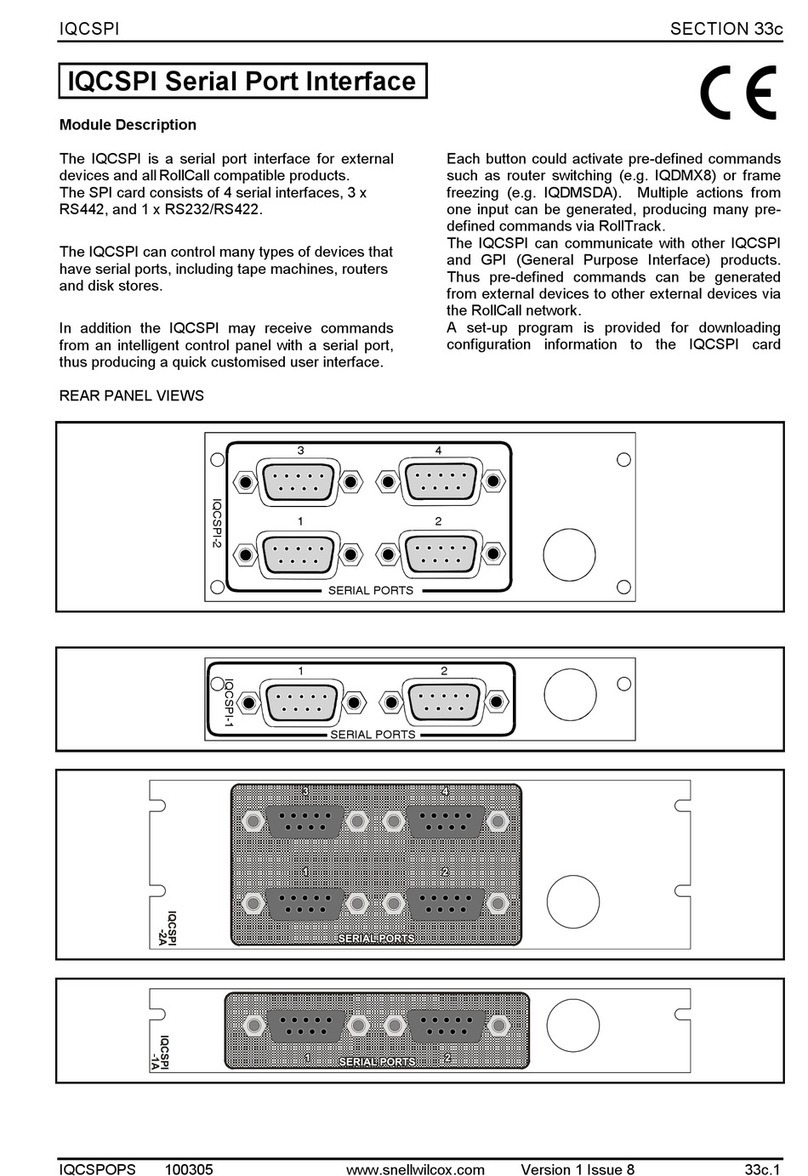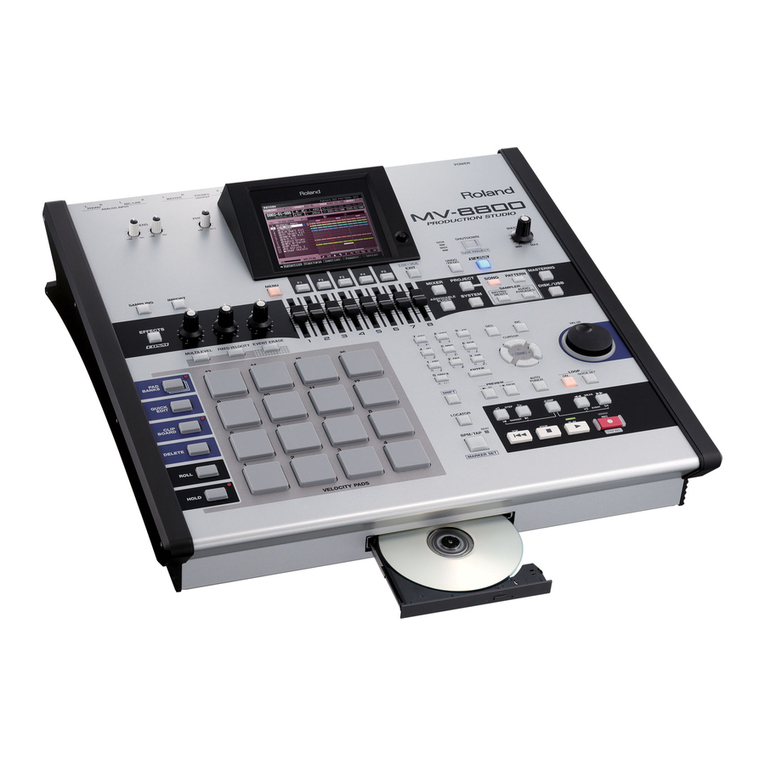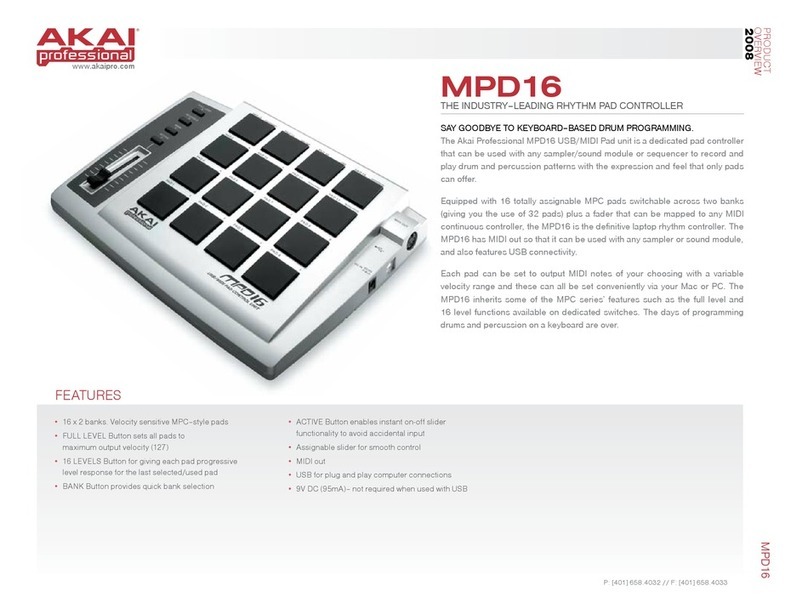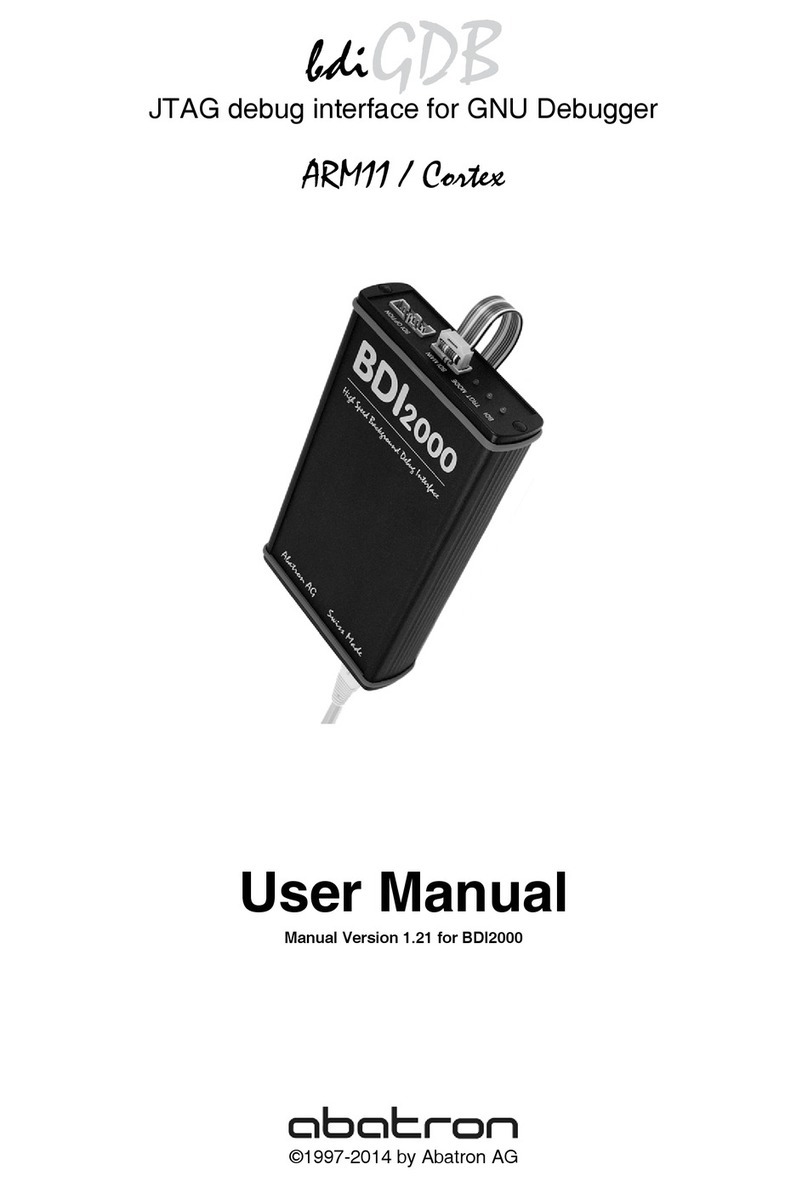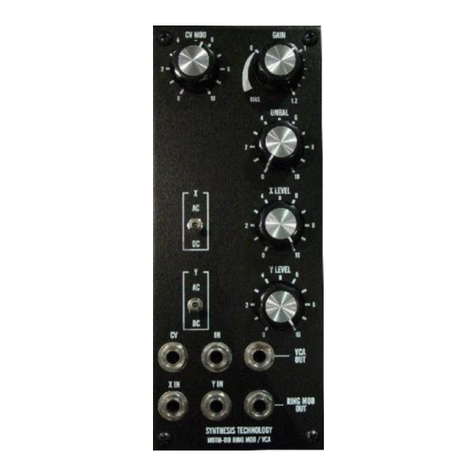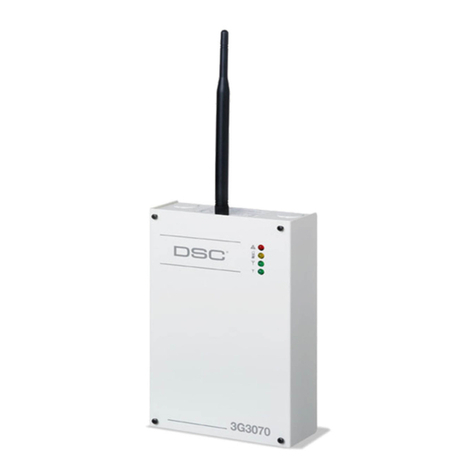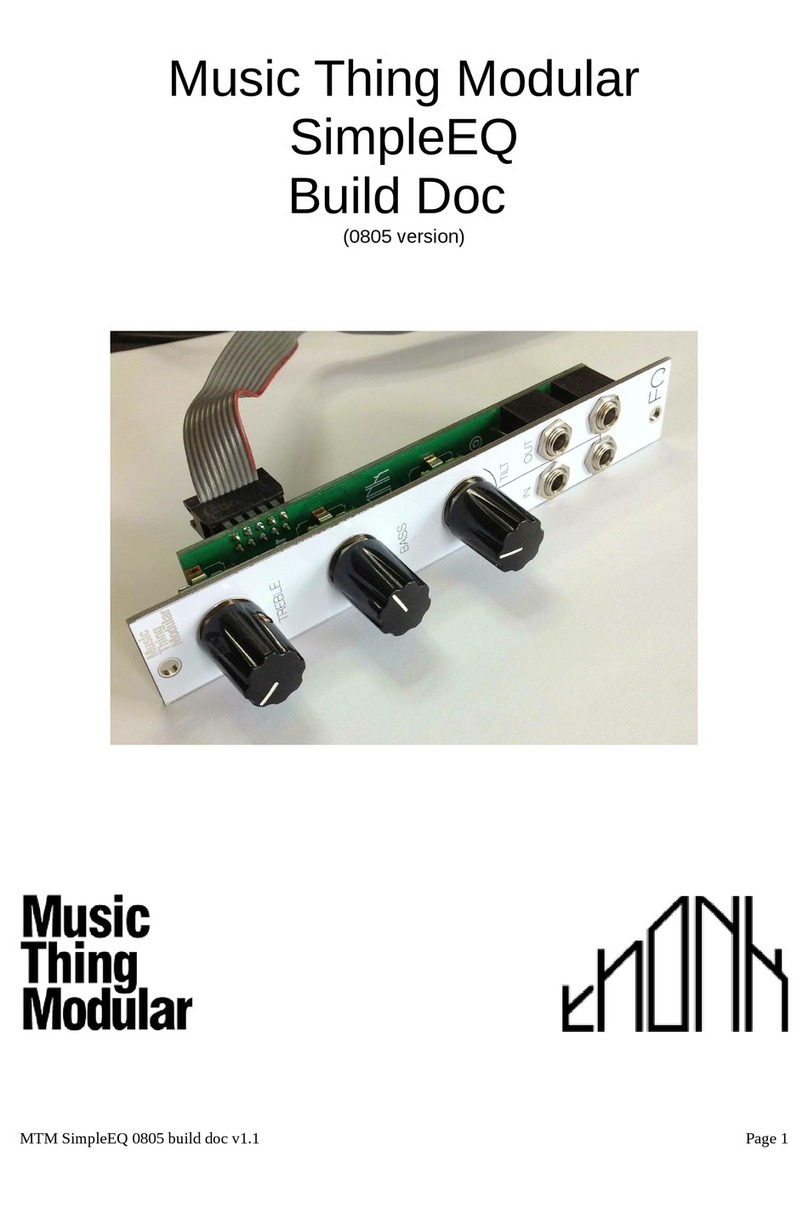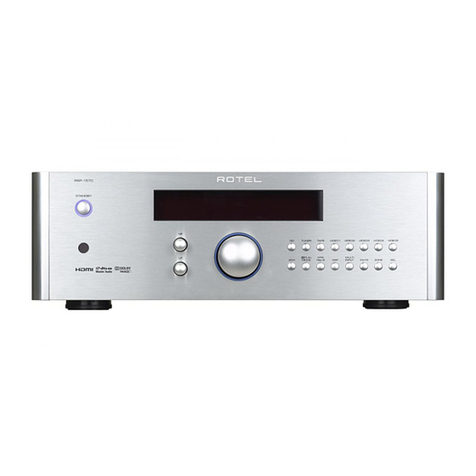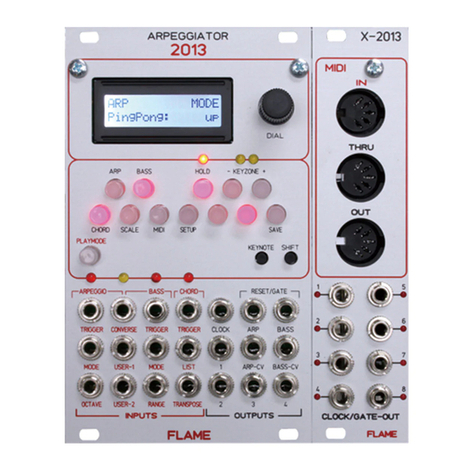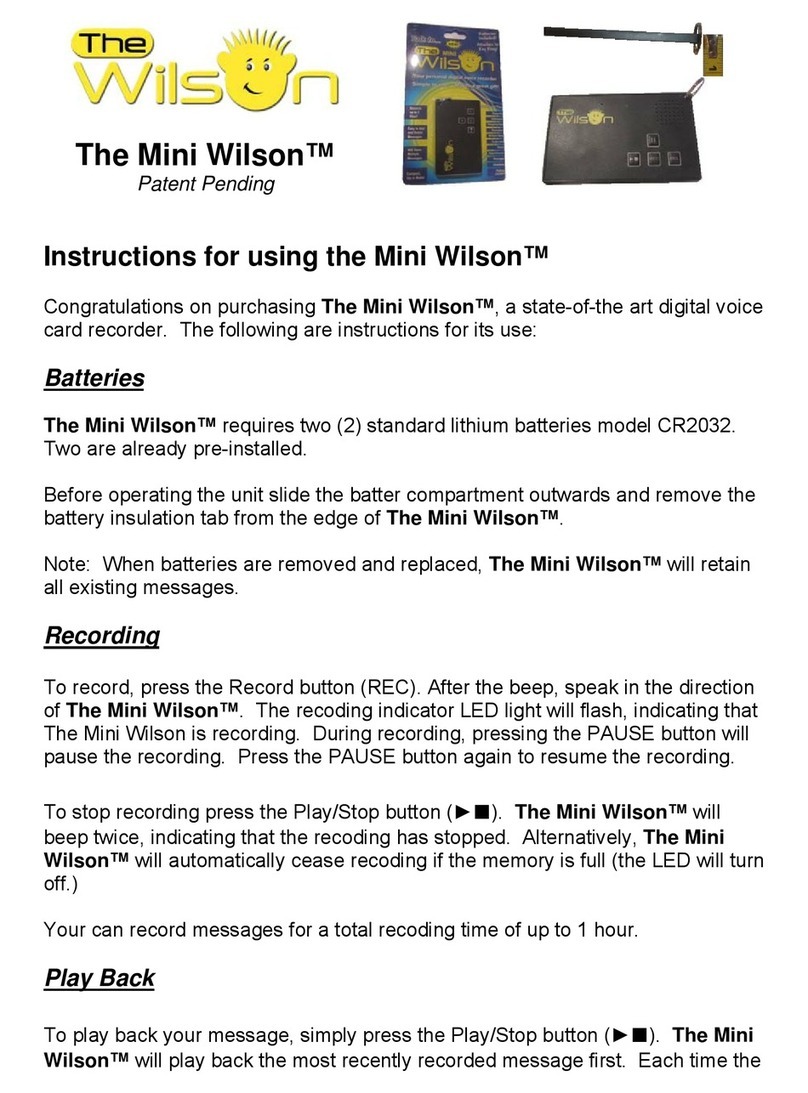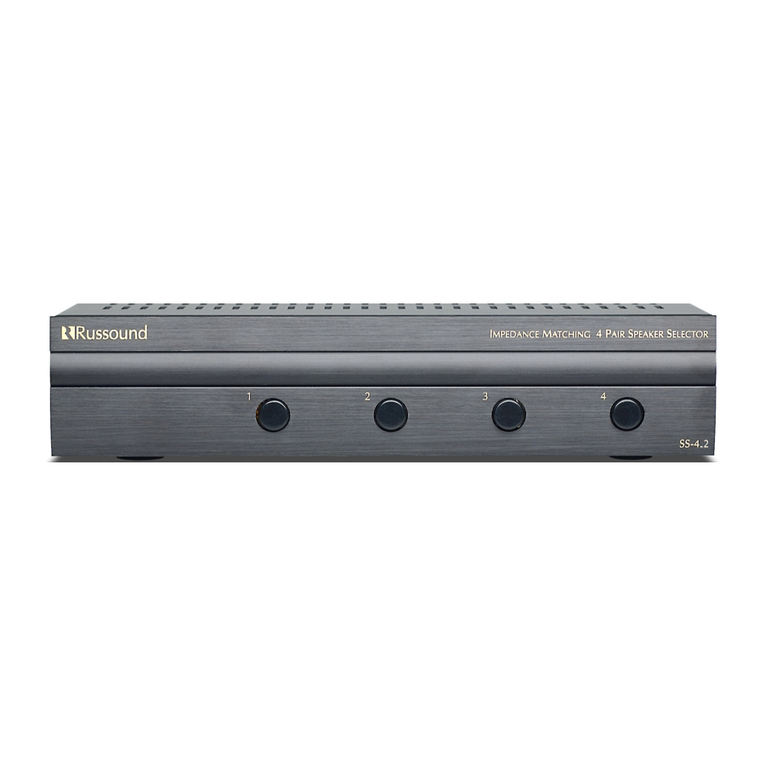Storm Audio ISP 3D.16 ELITE Assembly instructions

ISP 3D.16 ELITE
ISP 3D.32 ELITE | Analog Edition
ISP 3D.32 ELITE | Digital Edition
ISP 3D.32 ELITE | Reference Edition
Firmware: 3.1r0
Read Me First...
If you need
help...
1. Check the online help of the Web
Installer Interface.
3. Contact our support team:
support@stormaudio.com
2. Check our website support page.
Installer Guide

1
Welcome
Thank you for choosing a StormAudio
Immersive Sound Processor. This guide
provides step-by-step instructions for
setting up your ISP.
The ISP range shares the same backbone,
but models dier by the options that are
installed.
This guide will describe the setup of
the Reference Edition version being the
most feature-packed unit. The same process
applies to other models, only the wiring
and some elements of the setup will dier.
We continuously strive to improve our products.
Some features might thus be added or be improved.
Make sure to check whether the installed rmware
version matches the installer guide version.
What’s In the Box
Installer Guide
Safety Instructions
Immersive Sound
Processor
Firmware 3.1r0
Power cord *
* depending on the region, the power
cord will be delivered with Fuse to be
installed
** tools are required to mount/unmount
the rack mount ears:
Torx screwdriver (T10)
Rack mount ears **

2
Before You Begin
1. In case the AC cord is delivered with Fuses attached, make sure to install them before
connecting the unit.
2. Ensure your electrical circuit has a good ground connection with all audio equipment
connected to the same ground node to avoid ground loop.
Display / Projector
XLR cables
RCA cables
Optical Toslink wire
HDMI Cable
Amplier units Speakers with cables LAN router
with Cat5/6 RJ45 cable *
3. Required equipment:
* the ISP needs a DHCP server to be part of the Network to get an IP address allocated.
Make sure to check your Internet Provider box or LAN/Switch box for router function.

3
The installation of the ISP is made following an easy ow of conguration using an integrated
Web Server. We have divided this Flow into several key steps, as shown below:
Installation Flow
1Sources connection to the ISP
2Power up, Web Installer Interface access and general description
3System conguration : password, access management and Network
4Inputs denition and conguration
5Theater and Audio Zones, creation and conguration
6
Settings of Triggers, AV delays, limiters, display and 16ch AES input
7
Denition of Listening Presets with Theater and Audio Zones allocation
8
Outputs connection to ampliers and subwoofers
9
Connectors and 16ch AES input descriptions, inputs table
10 Remote Control interfaces: Web Remote and StormRemote
4
5
10
11
12
35
38
40
41
46
11
Room Calibration with Dirac Live Room Calibration Tool 23
TM

Hardware Connections
Inputs
1
4
1
2
3
45
6
1. Check Fuse and install the proper Fuse if required
2. Connect AC cord to Power Outlet (do not turn ON now)
3. Connect the RJ45 LAN Network cable to the router/switch
4. Connect your Digital Sources via Coaxial or Optical
5. Connect your Analog Sources via RCA
6. Connect your HDMI sources (HDCP2.2 on HDMI IN 1, HDCP1.5 on HDMI IN 2 to HDMI IN 8)
7. Connect your Video Server with Multichannel AES/EBU Output via 2x RJ45
8. Connect your displays (HDMI OUT 1 is HDCP1.5, HDMI OUT 2 is HDCP2.2, same content)
1.1) Connect the unit as shown below. Do not connect the outputs at this stage:
allocation is made automatically during setup (Step 5 of this document).
1.2) Multiple connections are possible. Take note of your sources’ connections to the ISP
by using the table of part 11, where you can also nd connectors pinout.
7
8

Web Installer Interface
Access & Help
2Power Up IP Address Login Navigation Online Help
5
2.1) Power On the unit following below steps :
1
2
3
1. Turn the Main Switch to ON (I) on the back panel.
2. Display will show StormAudio logo for few seconds and will
enter the Sleep Mode (Led turns red continuously).
3. When in Sleep Mode, press the Power Button. Unit will start.

Web Installer Interface
Access & Help
2Power Up IP Address Login Navigation
Online Help
Online Help
6
2.2) Check for Network Address :
1. Press EDIT button for about 3s
2. The display will show a list of system information, including the
IP address allocated via DHCP
3. Take note of this address:
eth IP Addr :
eth MAC Addr :
wifi IP Addr :
wifi MAC Addr :
hostname :
192.168.1.172
b8:27:eb:70:2b:2c
None
None
ISP 3D.16 ELITE
serial number : ISP16-E-N00006
temperature : 35 °C
FAN speed : 50%
fw version : FW2.0r6
IP Address
13s 2

Web Installer Interface
Access & Help
2Power Up IP Address Login Navigation Online Help
7
2.3) Use your computer and open a Web Browser.
2.4) In the URL area, enter the IP address of your unit (such as 192.168.1.172) and validate.
2.5) The Home Page will be shown as below :
Selecting this button
will give access to
End User Remote
Control page (see 9)
Selecting this button
will give access to
the Expert Setup
to congure the ISP
Select the
Expert Setup
The Expert Setup has two levels
of access : Installer and Expert User.
Expert user gets access to portions
of the setup dened by the Installer.
Installer user gets full access to the setup.
Conguration is done at the Installer level.
Type the default password for Installer being:
installer
And press CONNECTION

Power Up IP Address Login Navigation Online Help
Web Installer Interface
Access & Help
2
8
Master Volume of the selected Theater
can be adjusted here. MUTE is available
as well as a DIM function that turns
the Volume down by an amount dened
in the Settings page (see part 6).
Conguration of the ISP is made in few
tabs split in the following categories:
- System parameters (1)
- Inputs denition (2)
- Speakers allocation and Room
Calibration for Mains and Alternate
outputs (3)
- General settings (4)
- Listening Presets (5)
Once congured you can control
the ISP via the Remote Pages (6)
1234 5 6
In some cases, it might be
required to restart the ISP
by pressing the RESTART button.
Note that this will not erase the
stored settings.
Pressing LOG OUT will take you
back to HOME page with only
possible access to REMOTE control.
2.6) Select Expert User again. You will access the System Page of the ISP.
2.7) The Web Installer Interface is structured around a common part on the top area
that will remain accessible at all time and give access to the basic functions.
This area provides the means to
change some of the settings at anytime
without having to access the Remote
Control page. Can be changed: Source, Preset,
Theater (and related EQ) and Surround mode.
To help you understand all the functions and
settings of the product, an Online
Contextual Help is accessible. By turning it to ON,
question marks will pop up next to each
function. Simply click on it for the function you
need help on.
!A single instance of the Web Interface should be activated
for a proper and smooth conguration.

Power Up IP Address Login Navigation Online Help
Web Installer Interface
Access & Help
2
9
2.8) In order to support the Installer in his conguration process in the best way possible,
we have developped an Online Contextual Help that can be activated at anytime as
shown in 2.7.
This Help Guide provides detailed information on each item you can adjust or consult
during the ISP Conguration. Thanks to this tool, the Installation Guide you have
in hands at the moment can be kept quite light.
More importantly, we work continuously on improving or adding features to the product.
Such Online Help can be updated at the same pace as the Firmware.
2.9) The rst level of Help consists on information about how the function works and
how to congure it. It is highlighted as a «Question Mark» in blue background.
Standard information will be visible only with Help set to ON.
2.10) The second level of Help consists on critical information warning the user about
specic and important information about a function and how to adjust it.
Warnings are always visible on the Web Installer Interface.
?
!

Web Installer Interface
System setup
3Network Passwords Access Management
10
In the System page, you can visualise hardware and software status of the ISP, change
password for Expert and Installer access, modify the Network parameters and dene
the access level of the Expert user level. It is also possible to backup and restore the
Conguration. Follow the Steps dened below to congure these settings.
By default, DHCP is
set to Auto. If a Static
IP address must be
dened, press the
DHCP AUTO icon.
Then enter the IP
address and router
settings.
1
If required, you can
change the passwords.
Note that default Expert user
password is expert.
2
Later in the conguration it will be
possible to save the conguration
as a backup le. It will also be
useful to Export the parameters
for the wiring of the Outputs.
Finally, Upgade of the unit
Firmware is done here.
Dene here the access level
the Installer wants to
grant to Expert user
i
i
i
This area provides info on
your unit with Software
revision, options installed
and possibility to download
Logs for support matters
3
4To complete the System page conguration,
you must SAVE then select INPUTS

Web Installer Interface
Inputs setup
4Inputs name Sources assignment Control Adjustment
11
Using the table you have lled up in previous step , you will now adjust the Inputs
of the ISP. By default, as many inputs as there are available physical connections have
been created. Follow the below steps to modify them.
1
1 2 3 4 5 6
For each input to dene:
1. Select a predened name or press Edit to change it.
2. Select which HDMI input should be activated.
3. Dene what physical audio signal to play amongst Analog, Coaxial, Optical, HDMI or 16ch AES
when this input is selected in the Remotes.
4. To compensate for level dierence between inputs, you can adjust input level.
5. To compensate for specic synchronisation issue with the connected source, you
you can adjust an AV delay per input.
6. Once dened in Settings page (see part 7), you can congure Triggers to activate
when the Input is selected.
7. To complete the Inputs denition, press SAVE then Main Speakers (8) to access next step.
7
8

12
Web Installer Interface
Speakers setup
5Principles Creation
Theater conguration
Layout Replication Bass
Speakers Adjustments
Distance Manual
Management Noise
Generator Levels Equalization
Audio
Zones
Depending on your ISP, your system will support up to 32 channels on Main Outputs
(with ISP-O-16-32 XLR and/or ISP-O-Digital Out installed) and 16 additional channels
on Alternate Outputs (with ISP-O-Dual Theater). For both sets of outputs, the Speakers
conguration will follow the same ow, as described below.
1
2
1. A single ISP can manage several Theaters and switch from one to
the other during playback. A Theater can be dened according to
a Speaker Layout. By default a Theater is proposed in a 2.0.0.0 layout.
2. The mapping (Signal --> Output Channels) is shown on a per
Theater basis with dierent colour.
3. New Theaters or Audio Zones (Mono/Stereo) can be added.
3
At this stage, you can decide to EDIT the Theater 1 if the Layout meets your requirements.
If the case, go to step 5.6 (Bass Management & Distance). If not, go to step 5.1 in next page.
Please note that in case «ISP-O-Dual Theater» option is installed (Alternate Speakers), you should make
sure before selecting EDIT that the current Preset (therefore Theater) playing is from the same channels
bank: Main or Alternate Speakers bank.
i
i
i
!

Web Installer Interface
Speakers setup
5Principles Creation
Theater conguration
Layout Replication Bass
Speakers Adjustments
Distance Manual
Management Noise
Generator Levels Equalization
Audio
Zones
13
5.1) If the default Theater 1 doesn’t t your need, you have to replace it.
Press Edit then Delete as shown below.
5.2) To create a new Theater, select Create Theater, it will appear as shown below. By then
pressing Congure, you will go to the Speakers Layout selection and conguration steps
described in next page.
At this stage you can also create Stereo/Mono audio zones. We do recommend to rst dene the
Theater and use remaining channels for Audio Zones creation. See step 5.10 for Audio Zone creation.
Theater conguration is made in 3 steps: Creation (5.1 & 5.2), Speakers Layout selection (5.3) and
Speakers/Subwoofers Replication denition (5.4 & 5.5).

Web Installer Interface
Speakers setup
5Principles Creation
Theater conguration
Layout Replication Bass
Speakers Adjustments
Distance Manual
Management Noise
Generator Levels Equalization
Audio
Zones
14
5.3) Speakers Layout selection.
1
2
1. To make the Speakers Layout denition easier, we have made a short
list of Recommendations. If you don’t see the Layout you need, select
All. The List will show more with a highlight on the Recommendations.
i
3
i
2
2. You can visualise the basis layout graphically
by selecting View and in the table with the
channels ticked.
3. Select the Layout that meets your requirements.
Information about compatibility of the selected
layout with the Dolby Atmos, DTS:X and Auro-3D
is also given via a color code.
«View» selection
Green: Fully optimized
Yellow: Supported
Orange: Not optimized
Red: Not supported
i

Web Installer Interface
Speakers setup
5Principles Creation
Theater conguration
Layout Replication Bass
Speakers Adjustments
Distance Manual
Management Noise
Generator Levels Equalization
Audio
Zones
15
5.4) The basic layout can be tuned to meet your exact speaker conguration, being
multiway, with replication of some channels and/or with several subwoofers.
1
2
3
45
1. For LCR, you can dene as many ways as you want. Generally up to 3.
2. Replicate surrounds to meet seating row count.
3. Indicate the number of subwoofers required («0» if no Subwoofer required).
4. Dolby Atmos oers the option to simulate its ceiling speakers via «top ring»
speakers located in the main «front ring» speakers, so called Dolby Enabled
speakers. Dene here whether the Dolby Atmos top layer is reproduced with
such speakers.
5. Replication of other channels than Surrounds is possible: tick the Custom
Channel Duplicator to access the feature then enter numbers required for
each channel.
You can then select View 6 (see 5.5) and Save 7
6

Web Installer Interface
Speakers setup
5Principles Creation
Theater conguration
Layout Replication Bass
Speakers Adjustments
Distance Manual
Management Noise
Generator Levels Equalization
Audio
Zones
16
5.5) When View is selected in Step 5.4, you will be able to visualise what you have
made as adjustments: multi-way, replication, subwoofers...

Web Installer Interface
Speakers setup
5Principles Creation
Theater conguration
Layout Replication Bass
Speakers Adjustments
Distance Manual
Management Noise
Generator Levels Equalization
Audio
Zones
17
5.6) Once the Layout has been dened and saved, you get access to the Speaker based
adjustment. The Theater is shown with its channels allocation. At this stage you can
connect the Speakers to the system (please go to section 9).
1
2
1. For each Theater, multiple audio Proles can be created. A Prole is the combination of the Speakers
denition (levels, delay, bass management...), Manual EQ and a Dirac lter design if applied (see part 6).
2. Adjust the crossover lters (Low, Middle and High) of LCR Multiways Speakers with cut-o frequency
and slope. For more than three ways, additional lters can be adjusted via the Manual EQ (see part 5.9).
3. For each Speaker of the system, you have to dene how they should manage the low frequency.
For small speakers, it is recommended to set them to small so the low frequency are redirected to
the Subwoofer channel. You can set frequency and slope.
4. When Speakers are set to Large, it is possible to redirect the LFE channel to them. Change this setting
from None to a level between 0 to -20 dB, 0 dB being the highest.
5. With Manual EQ and the Dirac Filter Design corrections applied, the average output level in the Theater
might be lowered signicantly. You can boost this average output level between 0 to 9 dB, in 3 dB steps.
Note that setting a too high level can lead to clipping.
4
3
5
!

Web Installer Interface
Speakers setup
5Principles Creation
Theater conguration
Layout Replication Bass
Speakers Adjustments
Distance Manual
Management Noise
Generator Levels Equalization
Audio
Zones
18
1
1. Subwoofer channels have specic ltering for the LFE content (bass channel from decoder). You can
dene a high pass lter to avoid rumble from subwoofer limited in the low frequency and a low pass lter.
2. You can adjust the Distance between the listener and the listening sweet spot, usually in the middle of
the sitting area. By default they are in «m» for meters, but you can select «feet» or «ms» reecting more
delay. The latter is usually used to ne tune a distance.
If you intend to do the Automatic Room calibration process using the Dirac Live Calibration Tool
and the Integrator Calibration kit, you don’t need to adjust the Distance/Delay and the Levels of
the Speakers in the Theater. Nevertheless, any required Manual EQ should be adjusted prior to
going through the Automatic calibration process. See next parts 5.7 to 5.9, otherwise proceed to
part 6.
2
!

Web Installer Interface
Speakers setup
5Principles Creation
Theater conguration
Layout Replication Bass
Speakers Adjustments
Distance Manual
Management Noise
Generator Levels Equalization
Audio
Zones
5.7) Next steps are level adjustment and manual equalization. To make these adjustments
comfortable and eventually using Microphones with Capture systems, a Noise Generator
is provided. You can set up how the Generator works as described below.
1. Press Setup, the Group
congurator will pop up.
2. Dene Groups of speakers
that should play the noise
at the same time.
3. Make sure the Speaker is
enabled.
4. Once Groups are dened,
simply close the window.
1
2 3
4
19
Other manuals for ISP 3D.16 ELITE
1
This manual suits for next models
3
Table of contents
Other Storm Audio Recording Equipment manuals
